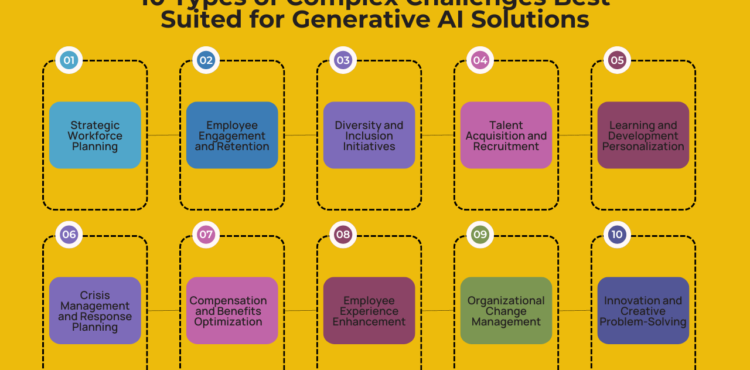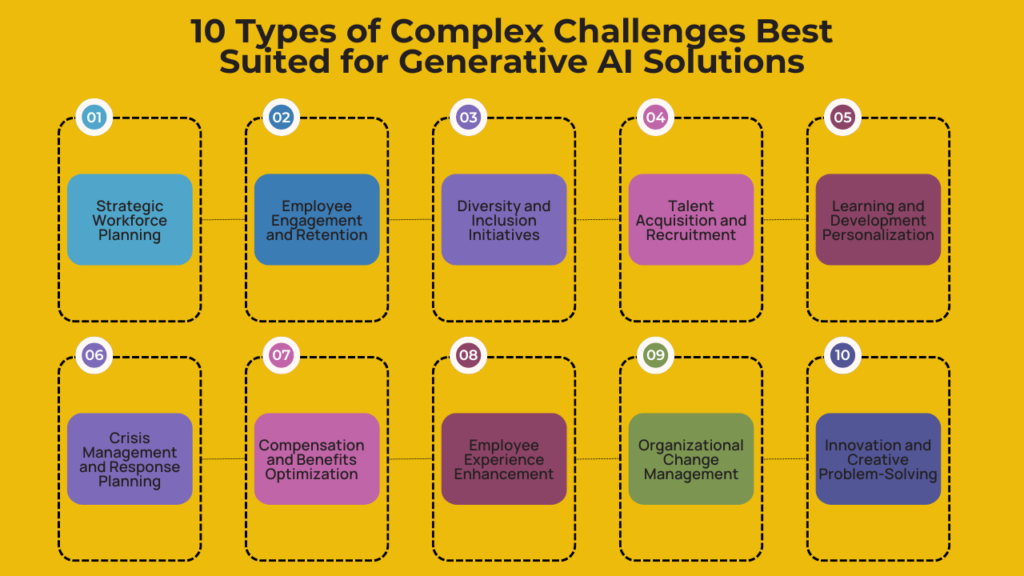
Generative AI in Problem-Solving: Strategies for Tackling Complex Challenges in the Workplace
Simple problems are getting more complex, and complex problems are getting a lot more complex. For example, how to create a global, remote work culture where people feel that they belong? How to foster continuous improvement, learning and development in growing organizations with limited resources? How to attract talent in competitive roles?
Traditional methods of problem-solving, while effective in the past, are now being complemented—and often transformed—by the advent of Generative Artificial Intelligence (AI). AI introduces new dimensions of creativity and insight into problem-solving that were previously unattainable.
How can HR professionals leverage Generative AI to address the complex challenges they face daily? What strategies can be used to ensure that AI-driven solutions are both innovative and practical, aligning with organizational goals while also fostering a culture of continuous improvement?
This article explains the role of Generative AI in tackling complex workplace challenges. We will explore key strategies for effectively utilizing AI, identify the types of challenges best suited for AI solutions, and outline a comprehensive six-stage process for integrating AI into your problem-solving workflows.

5 Key Strategies for Leveraging Generative AI in Problem-Solving
Using AI in problem-solving is not just about implementing the technology, but about aligning it with the specific needs and challenges of the organization.
The following strategies help HR professionals and leaders effectively utilize AI to tackle complex issues, ensuring that the solutions generated are both innovative and applicable.
- Define Clear Problem Statements: The foundation of any successful AI-driven solution lies in the clarity of the problem statement. Vague or poorly defined problems can lead to irrelevant or ineffective AI-generated solutions. By clearly articulating the challenge at hand, such as specifying the desired outcomes and constraints, HR professionals can guide AI tools toward generating more accurate and useful solutions.
- Incorporate Human-AI Collaboration: Generative AI excels in processing large datasets and identifying patterns that might not be immediately apparent to humans. However, it’s necessary to incorporate human insight into the process. You should view AI as a collaborator—one that can enhance decision-making by offering new perspectives, but which still requires human oversight to ensure that solutions are aligned with organizational values and goals.
- Focus on Data Quality and Diversity: The quality and diversity of the data fed into AI models are essential to the success of AI-driven problem-solving. High-quality, unbiased data allows AI to generate solutions that are more accurate and relevant. You must prioritize data integrity, ensuring that the information used to train AI models is representative of the diverse workforce and free from biases that could skew the results.
- Implement Iterative Problem-Solving Cycles: Generative AI is particularly effective when used in an iterative process. Rather than expecting a perfect solution on the first try, you should adopt a cycle of continuous improvement, where AI-generated solutions are tested, refined, and re-evaluated. This approach allows for the fine-tuning of AI outputs and ensures that the final solutions are robust and practical.
- Evaluate and Mitigate Ethical Risks: While Generative AI offers powerful tools for problem-solving, it also introduces potential ethical risks, such as bias in decision-making or unintended consequences. It’s essential to evaluate these risks continuously and to implement safeguards that ensure AI-driven solutions are fair, ethical, and in line with the organization’s values.
10 Types of Complex Challenges Best Suited for Generative AI Solutions
Read more HERE.